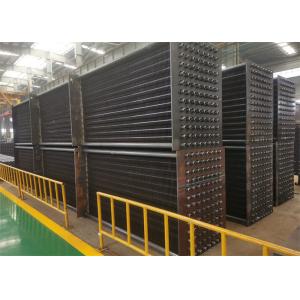

Add to Cart
High Heat Transfer Carbon Steel Boiler Economizer bank of H Fin Tubes Anti-Corrosion
Economizer Functions
H-type finned tube heat exchanger elements maintain a high capacity
for heat transfer, possess superior self-cleaning properties and
retain the ability to effect flue gas waste heat recovery in boiler
renovations. Convective heat transfer coefficient is proportional
to fin pitch, but inversely proportional to fin height and fin
width. Integrated heat transfer capacity is related to fin
efficiency, convective heat transfer coefficient and finned ratio.
Pressure drop increases with the increase of fin height and fin
width.
The primary effect of economizer is to absorb waste heat of flue
gas to heat boiler water supply, reduce smoke exhaust temperature
and advance boiler thermal efficiency. Feed water temperature forward and backward into the drum, reduce
the temperature difference between the water pipe and the drum
wall, thus reducing the thermal stress of the drum wall, is
conducive to prolong the service life of the drum. In addition, the water supply is heated in the economizer before
entering the transpiration heating surface, reducing the heat
absorption of water in the transpiration heating surface, which is
equivalent to replacing some of the transpiration heating surface
with the economizer. The cost of economizer heating surface is much lower than that of
transpiration heating surface. Therefore, it is economical to
install economizer from the perspective of boiler manufacturing
economy.
Economizer Types
If according to materials, economizers can be divided into steel
tube economizers and iron economizers. At present, most large and
medium volume boilers widely use steel tube made economizers,
because they have high strength and reliable working ability, and
are able to withstand impacts, meanwhile they have good performance
of heat transfer, small structure and low cost. One weak point is
bad corrusion resistance, but now the modern boiler feed water are
strictly treated, so the problem is almost solved.
If according to heating extension of the working fluid, economizers
can be divided into non-boiling and boiling types.
1. Boiling economizers: the outlet water temperature not only can
reach the surnatured temperature, but also can make some water
vapourized, the proportion is about 10-15% of total feed water, not
more than 20% in case of much flow resistance caused to the working
fluid.
2. Non-boiling economizers: the outlet temperature is 20-25 degrees
lower than the boiling point under pressure given.
Most of medium-presssure boilers use boiling type economizers. This
is because the latent heat of vaporization of water in
medium-pressure boilers is high, and the heat of the heated water
is smal. Thus it is necessary to send some water to be vaporized in
boiler economizer so as to prevent unstable combusion in funaces
and prevent increased consumption of metal in the heating surfaces
as superheaters caused by too low outlet flue gas temperature. In
addition, it can help to play the role of economizers.
Superhigh pressure boilers mostly use non-boiling type economizers.
This is because when the pressure is higher, the latent heat of
vaporization is decreased, while heat of the heated water is
getting more, so it is necessary to send some water to be heated in
water wall panels so as to prevent the slagging on the heating
surfaces of the furnace outlets and the furnace inside caused by
too high temperatures in furnaces and of outlet flue gas. So
usually superhigh pressure boilers use non-boiling type
economizers.
The main factor to consider which type of economizers is boiler's
parameters. When the boiler parameters differ, the ratio of heat
absorption needed in three stages to heat the working fluid make
differences. So the corresponding arrangements of three heating
surfaces need to change, too. To large units with high parameters,
their evaporative heat absorption is less, while the heat
absorption of water by heating, the heat absorption of steam by
superheating, the heat absorption by reheating are quite big. Thus,
non-boiling type economizers are the main type for superhigh
pressure unit boilers.
Specifications
| Description | Boiler economizer |
| Material | Alloy steel, Carbon steel, SA210C ,SA213T22, etc. |
| Material standard | ASTM, EN or ISO etc. |
| Dimension | Customization |
| Weight | Min: 10 ton |
| Smelting Process: | EF+LF + VD |
| Process | Material→Ingot → Hot/Cold-Rolling→ Heat treatment (Normalizing+ tempering) → Inspection →rough machining→UT →2nd Heat treatment →finishing machining →Inspection |
| UT standard | ASTM A388 or EN10228, etc |
Quality Control
1. Impact test and Strength calculation report with applied
materials information.
2. 100%NDT(non-destructive inspection) report of steel plate, tube
and electrode
3. X-ray, γ-ray and liquid penetrant test inspection report
(welding seam): to ensure the quality of the entire boiler
4. Hydraulic test report: ensure the standard working pressure and
safety
